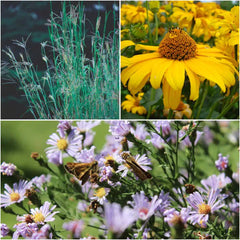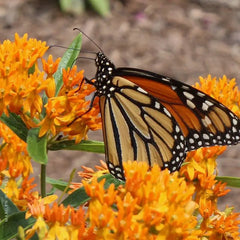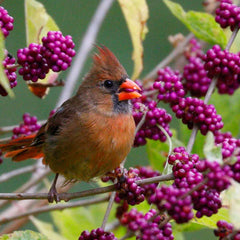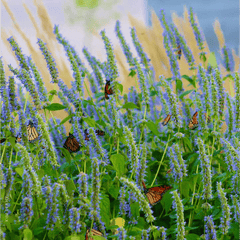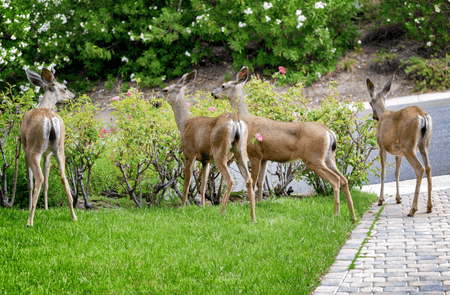Patio or Balcony Gardens for Wildlife

Creating a container wildlife garden with native plants is a fantastic way to attract wildlife, even if you don't have a traditional yard or lawn. Container gardening allows you to have a garden in spaces where traditional gardening is not feasible, such as balconies, rooftops, or small patios.
A small-scale wildlife oasis on your deck or patio can make a huge difference to local birds, migrating butterfly species and hundreds of other creatures each year. In wildlife conservation, good things really can come in small packages! And a small, but natural, space may qualify your home or apartment as a National Wildlife Federation Certified Wildlife Habitat.
Plan a Wildlife Garden for your Patio or Balcony

- Assess Your Space: Measure the available space and consider factors like sunlight exposure, wind conditions.
- Research Native Plants: Identify native plant species that are suitable for container gardening and attract local wildlife. Look for plants with flowers that provide nectar for pollinators like butterflies, bees, and hummingbirds, as well as berries or seeds that other birds can feed on. Consider plants of different heights and bloom times to provide a variety of food sources.
- Choose Appropriate Containers: Select containers that fit your balcony space and are suitable for the plants you've chosen. Make sure the containers have drainage holes to prevent waterlogging. Consider vertical gardening options like wall-mounted planters, hanging baskets, or trellises to maximize space utilization.
- Potting Mix and Mulch: Use a high-quality potting mix specifically formulated for container gardening. Avoid using garden soil, as it may not provide adequate drainage. Add a layer of organic mulch on top of the soil to help retain moisture and promote healthy plant growth.
- Plant Placement: Group plants with similar water and sunlight requirements together. Place taller plants towards the back of the balcony and shorter ones towards the front to create depth and visual interest. Utilize vertical space by installing trellises or plant stands for climbing plants.
- Watering and Maintenance: Regularly water your container garden, ensuring the soil remains consistently moist but not waterlogged. Monitor the plants for pests or diseases and take appropriate measures if necessary.
- Provide Food and Water Sources: Place shallow dishes filled with clean water on your balcony to provide drinking and bathing opportunities for birds and insects. Consider adding a bird feeder with seeds or nectar feeders for hummingbirds to attract more wildlife.
- Create Hiding Places: Incorporate planters with dense foliage or trailing vines to provide shelter and hiding spots for small birds and insects. This will also add visual appeal to your balcony garden.
- Maintain a Wildlife-Friendly Environment: Eliminate the use of pesticides and herbicides in your garden to create a safe and healthy environment for wildlife. Avoid using chemicals that could be harmful to the birds, bees, and butterflies you're trying to attract.
- Observe and Enjoy: Spend time observing the wildlife that visits your balcony garden. Keep a journal or take photographs to document the different species you attract. Make adjustments to your garden based on your observations and learnings.
Native Plants for Patio and Balcony Gardening

The key to successful wildlife gardening is sourcing native plants. Be sure to check a Native Plant Finder and buy plants for your state or zip code.
One consideration in selecting native plants for container gardening is to choose plants that won’t immediately outgrow the container. Depending on container size, some wide-spreading plants or plants towering over 2 feet may be difficult to manage in a container. We’ll dive into container types in a bit!
The color of your native plants can help with luring specific types of wildlife to your patio or balcony garden. With shades of purple, scarlet, and gold, the bold blooms of the our Patio Pollinator Collection will brighten your garden while attracting hummingbirds, butterflies, bees, and more. The small foot-print of these plants make it a great option for containers or pots - no yard required! This collection includes two of each of the following native perennial plants for full sun:
- Blazing Star
- Scarlet Sage
- Lanceleaf Coreopsis
Depending on where you live, here are other native plants that would work for patios, balconies or containers:
- Wild Bergamot (Monarda fistulosa): This perennial plant produces clusters of lavender flowers that attract bees, butterflies, and hummingbirds.
- Cardinal Flower (Lobelia cardinalis): This striking plant features bright red tubular flowers that are highly attractive to hummingbirds.
- Black-eyed Susan (Rudbeckia hirta): This popular wildflower produces golden-yellow daisy-like flowers that attract butterflies and bees.
- Wild Geranium (Geranium maculatum): This woodland native has delicate pink or purple flowers that attract bees and butterflies.
- Blue Wood Aster (Symphyotrichum cordifolius): This perennial plant showcases vibrant purple flowers that attract butterflies and bees in late summer and fall.
- Great Blue Lobelia (Lobelia siphilitica): This tall perennial with blue flowers attracts hummingbirds, butterflies, and bees.
It’s important to note that some plant combinations will look great for the first couple years, but in time one plant is likely to crowd out the others. You could divide them at that point, or simply start out with them in separate pots. All of our collections come with design ideas like the below.
Native Plant Garden Container Ideas
When it comes to accommodating large native plants on a balcony or patio, you'll need to think creatively to repurpose large containers or find alternative solutions. While you’re hunting for plant containers, keep an eye out for smaller, wider containers to provide clean water for wildlife.
Here are some ideas for large recycled containers for big native plants on a balcony:
- Plastic Barrels: Cut a large plastic barrel in half vertically or horizontally to create two deep planters. Ensure proper drainage by drilling holes in the bottom. Plastic barrels are durable and can house larger native plants like small trees or shrubs.
- Wooden Crates or Pallets: Find or build larger wooden crates or repurpose wooden pallets to create sizeable planters. Line them with landscaping fabric to prevent soil from spilling out. These can accommodate larger native plants and provide a rustic look.
- Wheelbarrows or Wagon Beds: Convert an old wheelbarrow or wagon into a mobile planter by filling it with soil and planting your big native plants. These containers are especially useful if you have limited space and need the flexibility to move the plants around.
- Bathtubs or Troughs: Old bathtubs or livestock troughs can be repurposed as large planters for big native plants. Make sure to drill drainage holes and elevate them with bricks or blocks to promote airflow and prevent waterlogging.
- Recycled Construction Materials: Look for recycled construction materials like concrete blocks, bricks, or stone slabs to build raised beds or planters. Arrange them in a way that accommodates the size of your big native plants.
Remember, when using recycled containers, ensure they are cleaned thoroughly and have proper drainage to prevent waterlogging. Additionally, consider the weight of the container and its suitability for your balcony's weight-bearing capacity. With these creative solutions, you can provide enough space for your larger native plants to thrive on your balcony.
Remember to be patient, as it may take time for wildlife to discover and inhabit your garden. With dedication and proper care, your container wildlife garden will become a thriving habitat for wildlife, supporting local biodiversity and providing you with a beautiful and rewarding space to enjoy nature.




